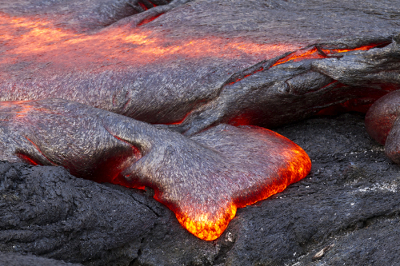Rocha ígnea extrusiva
Visão Geral
Fonte: Laboratório de Alan Lester - Universidade de Colorado Boulder
Rochas ígneas são produtos de resfriamento e cristalização de magma. Rochas vulcânicas são uma variedade particular de rocha ígnea, formando-se como consequência do magma rompendo a superfície, depois resfriando e cristalizando no ambiente subaerial.
Magma é rocha líquida que normalmente varia em temperatura de aproximadamente 800 °C a 1.200 °C(Figura 1). O magma em si é produzido dentro da Terra através de três mecanismos primários de fusão, a adição de calor, adição de voláteis e descompressão. Cada modo de geração de derretimento tende a produzir tipos específicos de magma e, portanto, estilos e estruturas eruptivas distintas.

Figura 1. Fuga de lava fresca em Kilauea, Havaí. Lava é o termo para magma que está na superfície da Terra.
Procedimento
1. Vulcão CO2
- Encha um recipiente de plástico com um pescoço fino (uma garrafa de refrigerante de 16 oz. por exemplo) cerca de meio cheio com água morna.
- Enterre a garrafa sob modelagem de argila ou massa, deixando apenas o pescoço (abertura) da garrafa exposta, simulando a estrutura de um vulcão.
- Adicione algumas gotas de líquido de lavagem de louça (a fim de tornar o líquido espumoso e provável que produza bolhas).
- Usando um pedaço de papel dobrado como funil, adicione
Resultados
1. Vulcão CO2
Durante o experimento de CO2, parte do material fluirá para fora como um fluxo de lava. A natureza espumosa do fluxo é uma reminiscência da lava que é carregada de voláteis. A maioria das erupções vulcânicas estão ligadas à perda volátil. Aqueles que são particularmente explosivos terão emanações voláteis consideráveis. Se o recipiente for rolhado, então a erupção inicial envolverá material tipo piroclástico que é eje...
Aplicação e Resumo
O volcanismo e as rochas associadas são de grande interesse para os geólogos. Não só as erupções vulcânicas representam uma ameaça para as comunidades próximas, como é importante reconhecer que elas também podem levar a paisagens cênicas e influenciar positivamente o solo e a produtividade agrícola.
Reconhecer rochas vulcânicas no campo, vinculá-las a estilos eruptivos específicos e verificar regiões de atividade passada fazem parte de avaliações geológicas fundamentais par...
Pular para...
Vídeos desta coleção:

Now Playing
Rocha ígnea extrusiva
Earth Science
40.0K Visualizações

Determinando a Orientação Espacial de Camadas Rochosas com a Bússola de Brunton
Earth Science
26.2K Visualizações

Uso de mapas topográficos para gerar perfis topográficos
Earth Science
32.4K Visualizações

Fazendo uma secção transversal geológica
Earth Science
47.6K Visualizações

Propriedades Físicas dos Minerais I: Cristais e Clivagem
Earth Science
52.1K Visualizações

Propriedades Físicas dos Minerais II: Análise Poliminalógico
Earth Science
38.4K Visualizações

Rocha ígnea intrusiva
Earth Science
32.7K Visualizações

Uma visão geral da análise de biomarcadores bGDGT para paleoclimatologia
Earth Science
5.5K Visualizações

Uma Visão Geral da Análise de Biomarcadores de Alquenonas para Paleotermometria
Earth Science
7.3K Visualizações

Extração por sonicação de biomarcadores lipídicos de sedimentos
Earth Science
10.0K Visualizações

Extração de Soxhlet de Biomarcadores Lipídicos de Sedimentos
Earth Science
18.6K Visualizações

Extração de Biomarcadores de Sedimentos - Extração Acelerada por Solventes
Earth Science
10.1K Visualizações

Conversão de Ésteres Metílicos de Ácidos Graxos por Saponificação para Paleotermometria Uk'37
Earth Science
10.1K Visualizações

Purificação de um extrato lipídico total com cromatografia em coluna
Earth Science
12.7K Visualizações

Remoção de Compostos Ramificados e Cíclicos por Adução de Ureia para Paleotermometria Uk'37
Earth Science
6.4K Visualizações
Copyright © 2025 MyJoVE Corporation. Todos os direitos reservados